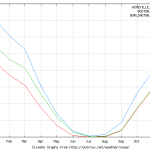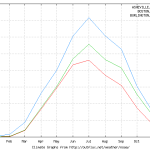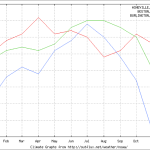There was a recent blog from Martin Holliday at Green Building Advisor on the Pretty good house approach. (https://www.greenbuildingadvisor.com/blogs/dept/musings/martin-s-pretty-good-house-manifesto )
It is an interesting and valuable look at building green homes. He is focused on cold climate building for the most part and so his pretty good rules of thumb need to be tweaked for our mixed humid climate. From the blog- “A well-known rule of thumb for cold-climate builders in North America is the 5-10-20-40-60 rule developed by the Building Science Corporation: windows should have a minimum R-value of 5 (equal to a U-factor of 0.20); basement slabs should be insulated to R-10; basement walls should be insulated to R-20; above-grade wall should be insulated to R-40; and attics or roof should be insulated to R-60.”
It led me to look up our heating degree days as compared to Boston, Mass and Burlington, Vermont just to see how much different it would be.
“Heating degree day (HDD) is a measurement designed to reflect the demand for energy needed to heat a building.” Wikipedia
These charts are from NOAA- https://outflux.net/weather/noaa/index.php
Asheville is red, Boston is green, Burlington is blue.
Heating Degree Days
ASheville 4640, Boston 6132,Burlington 7636

Cooling Degree Days
Asheville 953,Boston 775, Burlington 731

Average Days of Sunshine
ASheville 99 days,Boston98, Burlington Vt 58

We have the least heating degree days and the most average sunshine during the winter months, graphical reinforcement for the idea that Asheville has a great climate and one that would benefit from passive solar design.
What got me going on all of this was Number 5 in Martin’s post.
“5. We need to size and orient our windows with an eye to comfort and delight, not passive solar gains
Forget about specifying oversized windows for your south elevation. The bigger you make your windows, the more money you are wasting.
In other words, stop thinking that south-facing windows are a good way to heat your house.
Passive solar design principles from the 1970s need to be re-examined in light of an astute analysis made by Gary Proskiw. Proskiw wrote, “The reason the two window upgrades [in his study] fared so poorly, from an economic perspective, is that the space heating load in a NZE [net zero energy] house is very small compared to any other type of house. By adding window area or upgrading window performance, the space heating load is reduced but it is already so small that there is little opportunity for further savings.”
Proskiw concluded that “window area should be limited to that necessary to meet the functional and aesthetic needs of the building.” Isn’t that liberating? Just put in a window that looks good and suits your needs — no bigger. It’s pretty simple.
There is a side benefit to this approach: your house is less likely to overheat during the summer.
Of course, it still makes sense to locate your main rooms on the south side of the house (since people like natural light) and to locate your mudroom, pantry, hallway, and mechanical room on the north side of your house.”
I have lived in passive solar houses since 1981 so this was a hard pill to choke on. Reading “In other words, stop thinking that south-facing windows are a good way to heat your house” was shocking though in the end he does throw in “Of course, it still makes sense to locate your main rooms on the south side of the house (since people like natural light)”.
When I thought about this some more I realized it is likely mechanically correct for colder climates though it would be interesting to do the analysis for our milder and sunnier climate. But in the end I think it understates the other factor of passive solar and that is the human/sun connection. Sitting in front of a south facing high solar heat gain window on a cold, clear winter day is a simple pleasure with BTU rewards. Watching the sun move deeper into the room for winter and slide back out for summer is a system that connects us to what the sun is doing. The payback for the enlarged south windows begins with the first cold spell. Even lowering the night curtains to hold that gained heat has a satisfaction. In the shoulder seasons when the sun is bringing in more heat than desired lowering the curtains for shade or opening the door to cool is another interaction that connects you with the sun’s changing angle.
Since we are doing more than designing machines I think a passive solar design is still the way to go though the sizing probably does need adjusting to account for reduced heating demands.
Boone Guyton
“astute analysis made by Gary Proskiw. ” https://www.greenbuildingadvisor.com/blogs/dept/musings/study-shows-expensive-windows-yield-meager-energy-returns

